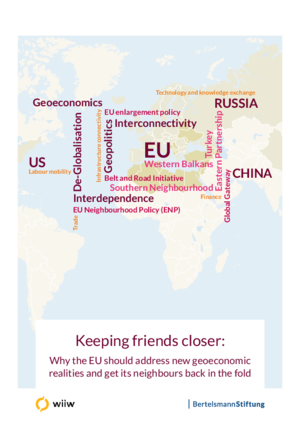Keeping friends closer: Why the EU should address new geoeconomic realities and get its neighbours back in the fold
Vasily Astrov, Richard Grieveson, Christian Hanelt, Branimir Jovanović, Artem Kochnev, Miriam Kosmehl, Isilda Mara, Markus Overdiek, Thieß Petersen, Olga Pindyuk, Oliver Reiter, Nina Vujanović and Stefani Weiss
Joint Study No. 2023-02, February 2023
in cooperation with BertelsmannStiftung
100 pages including 9 Tables and 59 Figures
Russia’s invasion of Ukraine has marked the start of a new geo-economic era for the EU. The invasion has dramatically intensified the EU’s ongoing economic and financial decoupling from Russia, which started in 2014, and adds to existing challenges, which are now assuming added salience: global economic decoupling between the US and China, the climate emergency and increasing irregular migration. Gaining a better understanding of the geo-economic challenges that the EU faces in its neighbouring regions and assessing their influence in relation to its peers and rivals are now of fundamental importance.
This study set out to measure the interconnectivity between the EU and its neighbouring countries1 and to compare these interconnections with those of the EU’s peers and rivals: the US, China and Russia. We have dealt with interconnectivity in five areas: trade, finance, technology and know-how, infrastructure and labour mobility. In doing so, we have sought to identify and measure the extent of these interconnections and to draw out the key geo-economic implications for the EU.
We find that the degree of interconnectivity between the EU and its neighbouring regions is very high. Across most areas of trade, finance, technological exchange, infrastructure ownership and labour mobility, the EU is the dominant partner vis-à-vis most of its neighbouring countries, and the gap between the EU and its peers and rivals is often vast. The EU only faces direct competition from the US, China and Russia in a few areas, and there are clear areas of complementarity when it comes to the US. Except in a few Eastern Partnership countries, Russia is rarely a rival. However, we do identify several areas in which China’s influence is growing and where it is increasingly a rival to the EU in its neighbouring countries. Moreover, at present, the EU’s strong economic, financial, technological, infrastructural and labour-mobility links with its neighbouring regions are not accompanied by comparable political influence. In an era of much stronger geo-economic competition, this is a problem.
From our analysis, we draw the following central conclusion: the EU must do more to safeguard its interests in its near abroad by leveraging its strong economic and financial influence. First, the EU should seek fairer, deeper and more sustainable trade integration with its neighbouring regions. Second, the EU should use its strong financial position in the region to drive positive change. Third, it must improve its technological competitiveness and push integration and harmonisation in this field more in its near abroad. Fourth, the EU should take more of a lead on regional infrastructure financing and fully include its neighbouring countries in the energy transition. Fifth, the EU should formulate a new approach to labour migration based on partnership with neighbouring regions. Finally, the EU should reinvigorate its partnership with the US (while also growing more prepared to stand alone), strike the right balance with China, and continue to decouple from Russia.
Keywords: Geoeconomics, trade, services trade, value chains, migration, mobility, remittances, economic integration, FDI, EU neighbourhood, connectivity, reserve currencies, technology, transport
JEL classification: F15, F16, F21, F22, F24, H54, N7
Countries covered: Albania, Bosnia and Herzegovina, Kosovo, Montenegro, North Macedonia, SEE, Serbia, Algeria, Armenia, Azerbaijan, Belarus, China, CIS, Egypt, EU, Georgia, Israel, Jordan, Lebanon, Libya, MENA, Moldova, Morocco, Russia, Syria, Tunisia, Turkey, Ukraine, US, European neighbourhood, Palestine
Research Areas: Labour, Migration and Income Distribution, International Trade, Competitiveness and FDI
